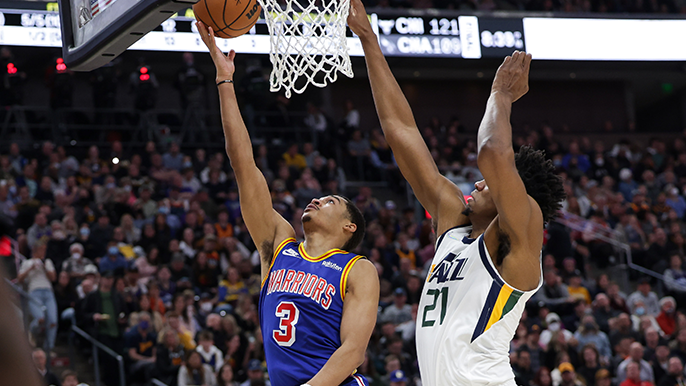
The Warriors scored the first 13 points of the game, but entered the second quarter with just a one-point lead. They scored the first six points of the third quarter, but lost the rest of the period by 14.
Every punch Golden State landed, the Jazz retaliated harder. In a game of runs, the Jazz had more bursts in them.
The Jazz dominated inside and got a major spark off the bench, while Stephen Curry (16 points, 4 turnovers) struggled to ignite Golden State’s offense. Utah’s convincing effort halted the Warriors’ league-best winning streak at nine, as Golden State (41-14) fell, 111-85.
Here are three takeaways from GSW’s loss.
Utah block party
The Warriors, not the Jazz, have the best defense in the NBA. You wouldn’t be able to tell just by watching Wednesday’s game.
Normally, the Jazz’s defensive scheme involves funneling drivers into Rudy Gobert at the paint. That’s where the three-time Defensive Player of the Year swallows up action better than anyone in the world.
But Gobert is out with a calf injury. In his stead, backup bigs Udoka Azubuike and Hassan Whiteside filled in valiantly. Their impressive presence made Stephen Curry’s buzzer-beating floater all the more spectacular.
But Curry’s scoop was the rare Warriors bucket inside. At halftime, GSW had just 10 points in the paint. Whiteside blocked six shots, and Azubuike rejected another in the first 24 minutes.
Too often, Golden State’s drives came off stagnant isolation drives. Any player is much more dynamic when attacking closeouts or slashing via off-ball cuts. Drives after dribbling are much easier for shot-blockers to time up.
Utah’s wings also chipped in by challenging shots at the rim. And even when plays didn’t result in a block, it seemed like nothing came easily for Golden State inside.
Whiteside’s season-high seven blocks made up most of the Jazz’s nine rejections. Utah outscored the Warriors in the paint 48 to 20 — the biggest difference-maker of the game.
Glass ceiling game
For the first time in NBA history, a team of all women led the broadcast.
Beth Mowins was on play-by-play, with Doris Burke working as the color analyst and Lisa Salters reporting from the sideline. They were supported by 30 women staffers working behind the scenes for the ESPN production.
“We’ve come a long way from the days when there was only one woman on the show,” Mowins told The Mercury News. “Hopefully we celebrate this marker once and then it’s not a big deal to see a bunch of women calling and working the NBA.”
The broadcast was historic. It was also…normal. Mowins, Burke and Salters are each excellent in their roles, and nothing about the broadcast — other than it being the first of its kind — was extraordinary. In the best way. Because why would it be?
Burke made insightful points about the Jazz with and without star center Rudy Gobert, including fair criticism of backup big Hassan Whiteside. Mowins was quick and enthusiastic with her narration. Salters conducted a candid, informative in-game 1-on-1 interview with Gobert, during which he committed to playing in the All-Star Game.
When asked about the historic broadcast before the game, Steve Kerr quipped that he’s always thought women should run the world.
“I think it’s great,” Kerr said. “I know some of the people involved. Just to be part of it is exciting. To understand what’s happening is exciting. It’s important and I’m really excited for the league and for the women involved.”
Trent Forrest, Warrior killer?
In his previous game against Golden State (he didn’t play in their first matchup), Trent Forrest scored nine points and snatched four steals in 18 minutes. He was everywhere.
Now with Joe Ingles out for the season — and on a different team — Forrest has an even bigger role. And he once again wrecked havoc on GSW.
There’s something about Forrest’s game that sneaks up on you. He makes lightning quick decisions in the halfcourt, a prerequisite for Quin Snyder’s system. He’s not overly aggressive, but has a twitch to him when he decides to make a move.
Defensively, Forrest plays with a motor rarely seen in the NBA. It’s on the level of a Marcus Smart or Patrick Beverley. One play, he forced a turnover by not giving up on the play after a missed Jazz shot, poking the ball loose from an unsuspecting Damion Lee in the backcourt.
Forrest recorded 11 points, five assists and a steal. He wasn’t the biggest reason the Jazz won, but he finished with a +23 plus-minus and was a major factor in the Jazz bench unit that outscored that of GSW’s 44 to 28.

